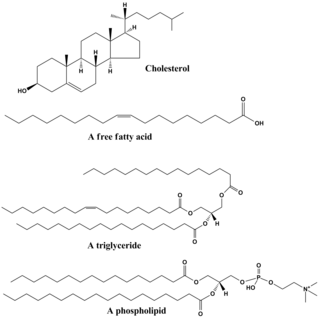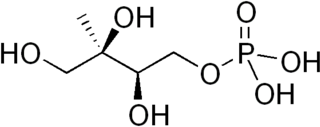Related Research Articles

Lipids are a broad group of organic compounds which include fats, waxes, sterols, fat-soluble vitamins, monoglycerides, diglycerides, phospholipids, and others. The functions of lipids include storing energy, signaling, and acting as structural components of cell membranes. Lipids have applications in the cosmetic and food industries, and in nanotechnology.

The mevalonate pathway, also known as the isoprenoid pathway or HMG-CoA reductase pathway is an essential metabolic pathway present in eukaryotes, archaea, and some bacteria. The pathway produces two five-carbon building blocks called isopentenyl pyrophosphate (IPP) and dimethylallyl pyrophosphate (DMAPP), which are used to make isoprenoids, a diverse class of over 30,000 biomolecules such as cholesterol, vitamin K, coenzyme Q10, and all steroid hormones.

Hopanoids are a diverse subclass of triterpenoids with the same hydrocarbon skeleton as the compound hopane. This group of pentacyclic molecules therefore refers to simple hopenes, hopanols and hopanes, but also to extensively functionalized derivatives such as bacteriohopanepolyols (BHPs) and hopanoids covalently attached to lipid A.

Isopentenyl pyrophosphate is an isoprenoid precursor. IPP is an intermediate in the classical, HMG-CoA reductase pathway and in the non-mevalonate MEP pathway of isoprenoid precursor biosynthesis. Isoprenoid precursors such as IPP, and its isomer DMAPP, are used by organisms in the biosynthesis of terpenes and terpenoids.

(E)-4-Hydroxy-3-methyl-but-2-enyl pyrophosphate (HMBPP or HMB-PP) is an intermediate of the MEP pathway (non-mevalonate pathway) of isoprenoid biosynthesis. The enzyme HMB-PP synthase (GcpE, IspG) catalyzes the conversion of 2-C-methyl-D-erythritol 2,4-cyclodiphosphate (MEcPP) into HMB-PP. HMB-PP is then converted further to isopentenyl pyrophosphate (IPP) and dimethylallyl pyrophosphate (DMAPP) by HMB-PP reductase (LytB, IspH).
The non-mevalonate pathway—also appearing as the mevalonate-independent pathway and the 2-C-methyl-D-erythritol 4-phosphate/1-deoxy-D-xylulose 5-phosphate (MEP/DOXP) pathway—is an alternative metabolic pathway for the biosynthesis of the isoprenoid precursors isopentenyl pyrophosphate (IPP) and dimethylallyl pyrophosphate (DMAPP). The currently preferred name for this pathway is the MEP pathway, since MEP is the first committed metabolite on the route to IPP.
Non-peptidic antigens are low-molecular-weight compounds that stimulate human Vγ9/Vδ2 T cells. The most potent activator for Vγ9/Vδ2 T cells is (E)-4-hydroxy-3-methyl-but-2-enyl pyrophosphate (HMB-PP), a natural intermediate of the non-mevalonate pathway of isopentenyl pyrophosphate (IPP) biosynthesis. HMB-PP is an essential metabolite in most pathogenic bacteria including Mycobacterium tuberculosis as well as in malaria parasites, but is absent from the human host.

Isopentenyl pyrophosphate isomerase, also known as Isopentenyl-diphosphate delta isomerase, is an isomerase that catalyzes the conversion of the relatively un-reactive isopentenyl pyrophosphate (IPP) to the more-reactive electrophile dimethylallyl pyrophosphate (DMAPP). This isomerization is a key step in the biosynthesis of isoprenoids through the mevalonate pathway and the MEP pathway.

2-C-Methyl-D-erythritol 4-phosphate (MEP) is an intermediate on the MEP pathway of isoprenoid precursor biosynthesis. It is the first committed metabolite on that pathway on the route to IPP and DMAPP.

Diphosphomevalonate decarboxylase (EC 4.1.1.33), most commonly referred to in scientific literature as mevalonate diphosphate decarboxylase, is an enzyme that catalyzes the chemical reaction

In enzymology, a 2-C-methyl-D-erythritol 4-phosphate cytidylyltransferase is an enzyme that catalyzes the chemical reaction:
In enzymology, a 4-(cytidine 5'-diphospho)-2-C-methyl-D-erythritol kinase is an enzyme that catalyzes the chemical reaction

2-C-Methyl-d-erythritol-2,4-cyclopyrophosphate (MEcPP) is an intermediate in the MEP pathway (non-mevalonate) of isoprenoid precursor biosynthesis. MEcPP is produced by MEcPP synthase (IspF) and is a substrate for HMB-PP synthase (IspG).
4-Diphosphocytidyl-2-C-methylerythritol is an intermediate in the MEP pathway of isoprenoid precursor biosynthesis. It is produced by the enzyme 2-C-methyl-D-erythritol 4-phosphate cytidylyltransferase (IspD) and is a substrate for CDP-ME kinase (IspE).
4-Diphosphocytidyl-2-C-methyl-D-erythritol 2-phosphate is an intermediate in the MEP pathway of isoprenoid precursor biosynthesis.
4-Hydroxy-3-methylbut-2-enyl diphosphate reductase (EC 1.17.1.2, isopentenyl-diphosphate:NADP+ oxidoreductase, LytB, (E)-4-hydroxy-3-methylbut-2-en-1-yl diphosphate reductase, HMBPP reductase, IspH, LytB/IspH) is an enzyme in the non-mevalonate pathway. It acts upon (E)-4-Hydroxy-3-methyl-but-2-enyl pyrophosphate (or "HMB-PP").

Aucubin is an iridoid glycoside. Iridoids are commonly found in plants and function as defensive compounds. Iridoids decrease the growth rates of many generalist herbivores.

In molecular biology, YgbB is a protein domain. This entry makes reference to a number of proteins from eukaryotes and prokaryotes which share this common N-terminal signature and appear to be involved in terpenoid biosynthesis. The YgbB protein is a putative enzyme thought to aid terpenoid and isoprenoid biosynthesis, a vital chemical in all living organisms. This protein domain is part of an enzyme which catalyses a reaction in a complex pathway.
Methylobacterium organophilum is a facultatively methylotrophic bacteria from the genus of Methylobacterium which was isolated from sediments from the Lake Mendota in Madison in the United States. Methylobacterium organophilum can degrade methanol.

Hartmut K. Lichtenthaler is a German botanist, plant physiologist and university professor.
References
- ↑ "Faculté de Chimie: Accueil - Université de Strasbourg". chimie.unistra.fr. Retrieved 2019-02-21.
- ↑ http://media.education.gouv.fr/file/Brochures/77/6/listelaureatsall12-2_25776.pdf [ bare URL PDF ]
- ↑ "IUF » Michel ROHMER". Archived from the original on 2008-11-26. Retrieved 2019-11-07.
- ↑ "Michel Rohmer : Repères biographiques - les membres de l'Académie des sciences". Archived from the original on 2009-05-29. Retrieved 2019-11-07.
- ↑ "American Chemical Society". American Chemical Society.